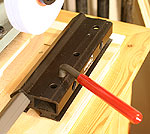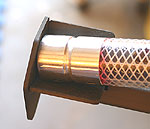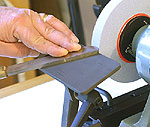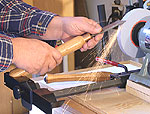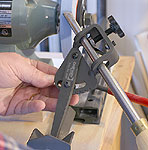This is a Veteran Owned site

Wolverine Grinding JigLight on fancy, heavy in function and valueText & Photos by Tom Hintz Sharp turning tools are second in importance only to the lathe itself. A clean, fresh cutting edge and consistent bevels are crucial to all woodturners but particularly so those with little experience at the lathe. If the tools are not working properly and consistently ground, learning presentation or technique is all but impossible. Discussions regarding sharpening equipment are standard fare on woodturning forums. Within those threads, endorsements of the Wolverine Grinding Jig are common. With so many current users voicing approval, NewWoodworker.com had to take a look. Initial ImpressionsThe Wolverine Grinding Jig is a prime example of Oneway Manufacturing's design theory. Simplicity, function and durability are always major criteria. Glitz, bells and whistles are nowhere to be found. The Wolverine Grinding Jig is a solid piece of equipment, made from durable steel materials intended to insure a long, accurate life. The fit and manufacturing of the components is first rate right throughout. The simple black finish is effective in protecting the steel without inflating the price tag. Instructions and SetupThe multi-page instruction sheet packed with the Wolverine Grinding Jig is clearly written and supported by many good quality line drawings and photos. The simplicity of the Wolverine Grinding Jig design means setup is very easy. Mount the grinder on a board, its shaft at the proper height and then screw the bases (there is a left and right!) in place. The only alignment is centering the diamond-shaped arm holes on the wheels width, the front edge of the bases even with the front edge of the wheel. Slip the Vee-arm and platform into the bases and the Wolverine Grinding Jig is ready for use. Bases
Made from a heavy-walled aluminum extrusion, the bases incorporate over-sized levers that operate an internal cam locking mechanism. This system presses a shoe against the arm to lock it tightly without damaging its surface. This design eliminates the dents and gouges setscrew style locks often create. Eliminating surface damage means the arm will not "index" into the groups of detents a screw would leave. This may seem like a small consideration but it eliminated the frustration of the arm moving slightly when secured which changes the angle of the tool to the grinding wheel. At 8"-long, 2 ¾"-wide and 1 ¼"-tall, the bases provide a very stable mount for the arms they support. Three countersunk holes make it easy to secure the bases to wooden base, as suggested in the instructions. Vee-ArmKey to the Wolverine Grinding Jig, the
design of the Vee-arm is remarkably simple in design but highly effective. That simplicity also carries over to setup and use. The 27 ½"-long arm is based on 1"-square steel tubing, stood on edge in relation to the grinding wheel for additional rigidity. A v-shaped bracket, welded to the end of the arm captures the butt end of chisel handles but allows them to be turned easily. Again, a very simple design that works exceptionally well. PlatformA 3"-deep by 5"-wide platform, also mounted on diagonally-positioned 1"-square steel tubing, is included. The platform is mounted on a pivot that allows matching bevels on flat chisels like scrapers and parting tools. The platform is locked at the desired angle with a
large, spring-loaded handle that can be easily positioned as needed. Grinders, Wheels & SpeedsOne of the attractive features of the Wolverine Grinding Jig is that it can be used with nearly any shop grinder. While slow-speed grinders are the rage in some quarters of the woodturning world, Oneway recommends a 8"-diameter wheel turning at the standard 3450 RPM. The instruction manual states that this combination provides an optimum speed of 7225 sfpm (surface feet per minute). When the wheel wears down to 6 ½'-diameter, normally considered the end of its useful life, the surface speed is still acceptable to Oneway at 5740 sfpm. The main idea behind using a slow-speed grinder is reducing the amount of heat generated in the chisel during sharpening. As I would discover, that process is remarkably fast with the Wolverine Grinding Jig and the recommended grinder, negating heat concerns almost entirely. When major re-shaping of the tool is required, a container of water in which to cool the tool between grinding passes will prevent compromising temper. In the ShopFor this review the Wolverine Grinding Jig was mounted to a piece of ¾"-thick plywood, along with my trusty Delta single-speed bench grinder. I decided to be sort of a devils advocate and use this grinder even though it has 6"-diameter wheels and turns at a constant 3450 RPM. That produces 5419 sfpm, slightly under the ideal range of 6000 to 8000 sfpm. The grinder was equipped with a pair of Oneway 6"-diameter grinding wheels in 80 and 120-grit. Both wheels were balanced on the Oneway Precision Balancing System, also reviewed on NewWoodworker.com. With the Wolverine Grinding Jig assembled to the platform as per the instructions all that remained was adjusting the Vee-arm length to fit the chisel. Color the bevel with a marker, lay the chisel in the holder with the bevel lying on the grinding wheel. Turn the wheel by hand and adjust the Vee-arm length until the bevel is flush with the wheel surface. The actual sharpening process with the Wolverine Grinding Jig takes far longer to describe than to do. Using the Vee-arm
The Vee-arm is designed to sharpen traditional bowl gouges and other curved chisels with straight edges such as roughing and spindle gouges. Touching up a cutting edge that already has the correct bevel is accomplished in just a few seconds, including turning the grinder on! Start the grinder, lay the bevel on the wheel and rotate it smoothly from one side to the other. No downward pressure is needed. The weight of the tool itself is more than adequate to maintain contact with the wheel. If the cutting edge is not damaged, one pass on the 120-grit wheel is all that is needed in most cases. The sharpening process is so fast there is no time for damaging levels of heat to build up in the chisel. With the 120-grit wheel turning at 3450 RPM, the finish on the bevel is remarkably smooth and ready for use. Depending on your habits, a quick scrub with a slip stone will remove the wire burr from the inside of bowl gouges. When the bevel requires shaping, move the Vee-arm to the 80-grit wheel, adjust the length for the desired angle and begin making quick passes. When the chisel begins to heat up, dip it in water to cool it down before grinding again. Even major shaping happens faster on the Wolverine Grinding Jig than expected. I changed the bevel angle on a 1"-wide roughing gouge by over 15-degrees in less than a minute. The gouge had to be cooled in the water twice during the process. After moving the Vee-arm to the 120-grit wheel and setting the angle, two quick passes cleaned up the new edge and the gouge was ready for use. Skew Sharpening
Oneway also offers a Skew Grinding attachment (#2690) that makes sharpening skew chisels just as fast. This attachment slips over the Vee-arm and is secured with a simple knob. Vee-shaped pockets at either end of the attachment hold the skew chisel at a 30-degree angle to the stone so both sides are sharpened identically. Once the arm is adjusted for the bevel angle, both sides of the skew can be sharpened by simply flipping it over and moving to the other pocket. As with the gouges, unless major changes are being made to the bevel, the sharpening process takes just a few seconds. The Skew Grinding attachment has a street price of about $30 (1-9-05). Swept-Wing Gouges
To handle the popular swept-wing (Irish grind) gouges, Oneway offers the Vari-Grind attachment (#2480). Used with the Vee-arm, the Vari-Grind fixture allows matching the sweep necessary to sharpen these tools accurately. A finger-operated knob secures the chisel in the holder and a knuckle below that is adjusted to replicate virtually any wing design. Clamp the tool in the Vari-Grind attachment, set the Vee-arm length to the bevel and a couple side-to-side passes are usually all that are needed to freshen the edge. When reshaping the bevel or wings is necessary, the Vari-Grind attachment makes that process fast and very accurate while minimizing the amount of material removed. The Vari-Grind attachment has a street price of about $50 (1-9-05). ConclusionsIf you own turning chisels, you need an efficient way to sharpen them. The Wolverine Grinding Jig is a well made, ingeniously designed piece of equipment that saves money with it's initial street price of $89.95 (1- 9 05) and being able to use it with a wide range of grinders. Unlike some sharpening machines, the Wolverine Grinding Jig is simple to set up and use. For the most common task of freshening a cutting edge, it is extremely fast. When reshaping a turning tool is necessary, the Wolverine Grinding Jig is again at the head of its class in terms off speed and efficiency. Do you have a comment about this page? - Email Me! |
All written, photographic and drawn materials are property of and copyright by NewWoodworker.com LLC 2000-2019. Materials may not be used in any way without the written permission of the owner.


